Which M4 Mac Is Best for Video Editing
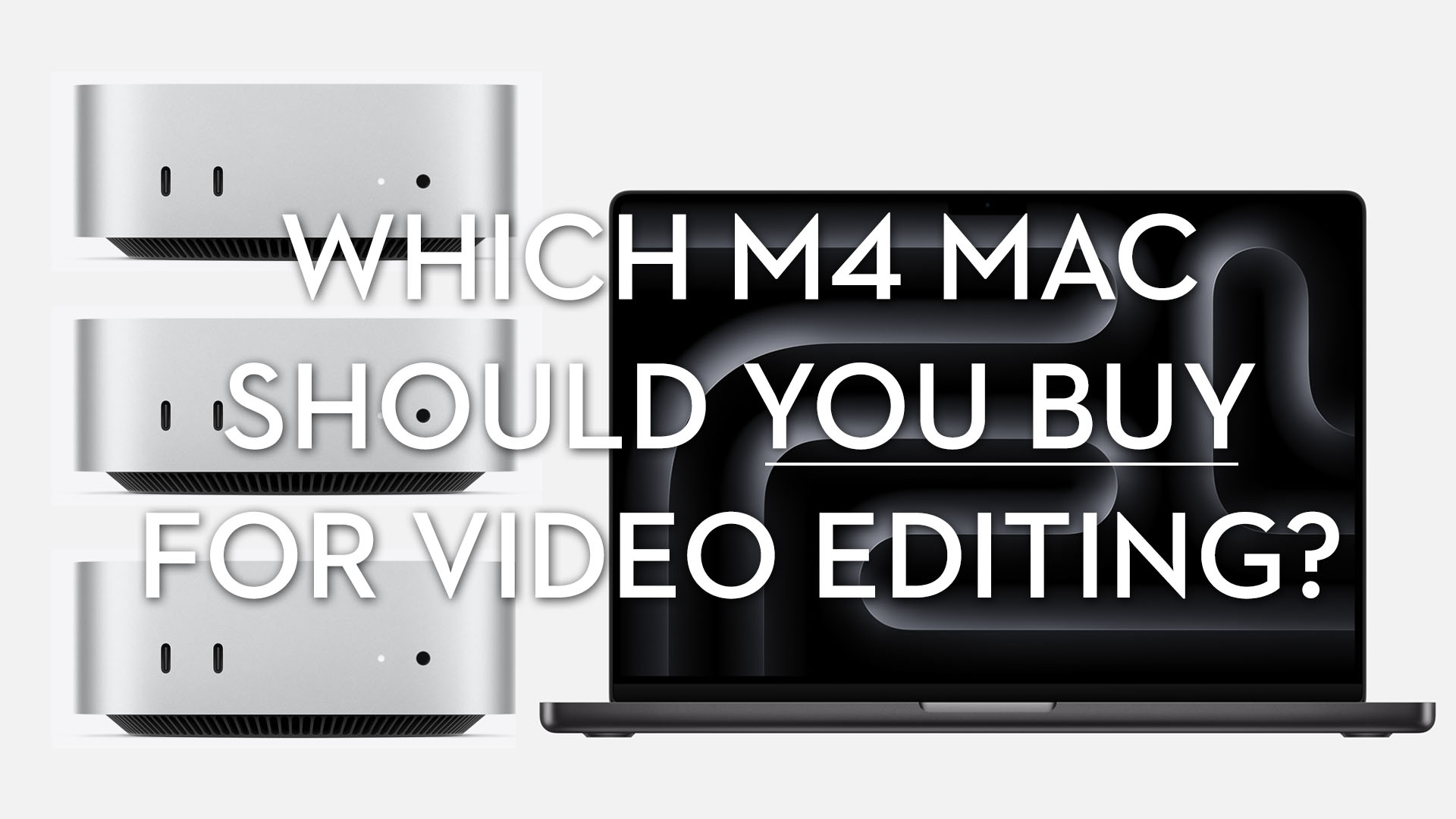
Is the new M4 Mac Mini suitable for video editing? Is it a better buy than the M4 MacBook Pro? What about the new M3 Ultra Studio?
As a professional video editor, I’ll be sharing answers to these and other questions as I decide whether to update to an:
- M4 Pro Mac Mini
- M4 Max Macbook Pro
- M3 Ultra Mac Studio.
If you’re in the same boat, read on.
Last Updated: 7th March 2025 + M3 Ultra Mac Studio
These Questions Will Be Answered
Keep reading for the complete answers but here they are in a nutshell:
- Which M4 Mac should I get for video editing?
- That depends – keep reading
- Is the base model M4 Mac Mini good enough for video editing?
- Yes certainly, it’s fantastic value.
- Which M4 Mac Mini configuration is best for video editing?
- Pro chip, Thunderbolt 5, 1TB SSD, 48-64 GB RAM
- Which M4 MacBook Pro is best for video editing?
- 16″ screen size, M4 Max, 48-64 GB RAM, Thunderbolt 5, 1TB SSD
- What M4 MacBook Pro upgrades are worth it?
- More RAM but this requires the top M4 Max chip.
- What about the M3 Ultra Mac Studio?
- In early tests, performance is exceptional with more Thunderbolt 5 ports, more RAM, and more video encoders.
Video Encoders Make a Huge Difference
One of the most time-consuming processes for video editors is exporting your final file. This is where the number of dedicated media encoders on the chips makes a huge difference.
- M4 Pro
- 1 x Video decode/encode engine
- 1 x ProRes encode/decode engine
- AV1 decode
- M4 Max
- 2 x Video decode/encode engine
- 2 x ProRes encode/decode engine
- AV1 decode
- M3 Ultra
- 4 x Video decode/encode engine
- 4 x ProRes encode/decode engine
- AV1 decode
So if you see export times of 10 minutes on a Pro they should be 5 minutes on a Max and 2.5 minutes on an Ultra, as the media encoders are doing a lot of the heavy lifting.
How to Spec a Mac for Video Editing

I mostly use two devices: a desktop and a laptop. I need the mobility of the laptop, but I spend a lot of time in my home edit suite, which used to be run by my spec’ d-out 2013 Mac Pro—until it died, and now my 2017 MacBook Pro holds down the fort.
So I’m considering both the M4 Pro Mac Mini and the 16″ M4 Max MacBook Pro.
I’ve detailed my ‘buying philosophy’ in the next section, but I’m looking for future-proofed performance that’s actually good value.
Given that, here’s how I’d configure either single purchase:
- Apple M4 Pro chip with 14-core CPU, 20-core GPU, 16-core Neural Engine
- 64GB unified memory
- 1 x set of media encoders
- 1TB SSD storage
- 10 Gigabit Ethernet
- Three Thunderbolt 5 ports, HDMI port, two USB-C ports, headphone jack
- Cost: $2,499.
- 16-inch Liquid Retina XDR display (Standard display)
- Apple M4 Max chip with 16-core CPU, 40-core GPU and 16-core Neural Engine
- 64GB unified memory
- 2 x set of media encoders
- 1TB SSD storage
- 140W USB-C Power Adapter
- Three Thunderbolt 5 ports, HDMI port, SDXC card slot, headphone jack, MagSafe 3 port
- Cost $4,199.
- Apple M3 Ultra chip with 28-core CPU, 60-core GPU, 32-core Neural Engine
- 96GB unified memory
- 4 x set of media encoders
- 1TB SSD
- 10 Gigabit Ethernet
- Six Thunderbolt 5 ports, two USB-A ports, HDMI port, headphone jack, SDXC card slot
- Cost $3999.
Note: You can only buy certain custom configurations like mine directly from Apple, but Amazon has a selection of options that are sometimes discounted by a small amount.
Read on to see which one I will choose and why I’m (probably) not waiting for the M4 Mac Studio.
The Best Price to Performance Configuration?
If you want to make my recommendations more affordable drop to 24GB RAM (-$600) on the Mac Mini and remove the 10 Gigabit Ethernet (-$100). Drop to 36 GB RAM (-$400) and lower M4 Max chip spec ($-300) on the MacBook Pro.
In that case, this MacBook Pro configuration may be the best value option: M4 Max, 14-core CPU, 32-core GPU: 36GB RAM, 1TB SSD at $3499.
This doesn’t future-proof you as much in terms of RAM and CPU but it does save you money.
To save even more money, the 16″ M4 Pro 14-core CPU, 20-core GPU with 24 GB RAM, and 1TB of SSD storage is $2,699, which is undoubtedly an incredibly good value editing machine.
For almost $1000 less the identical spec Mac Mini is just $1,799.
But know this.
Even if you bought the absolute cheapest M4 Mac Mini for $599 you could still edit video on it beautifully. I am editing video effectively on a 7-year-old laptop.
To go from an i7 to an M4 will feel monumental.
£/$ – I’ve listed all of the prices in dollars as Apple charges the same in pounds, despite the currency conversion difference!
The Best Way to Buy a Mac
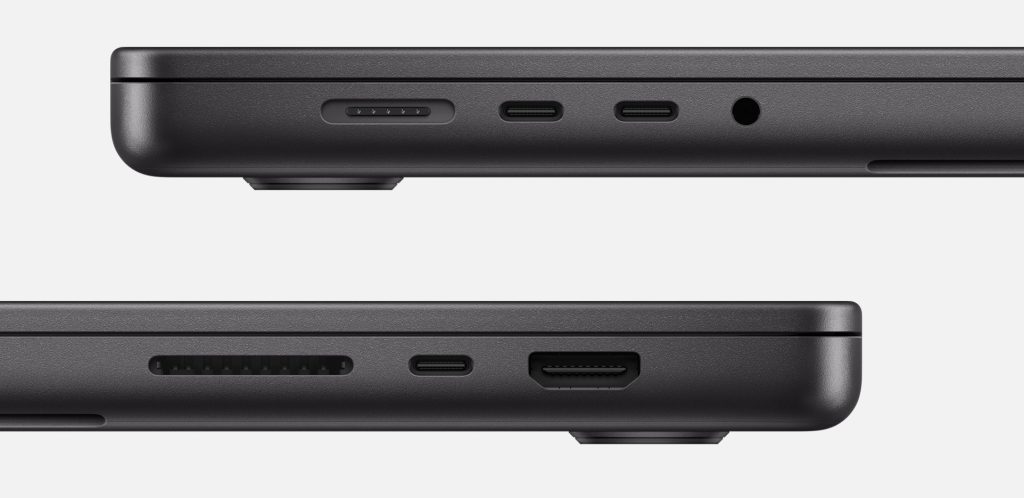
You might think about all this quite differently to me, but here’s how I think about spending thousands of pounds on hardware that is critical to my business as a freelance film editor.
My Purchasing Philosophy
When buying any new hardware I generally have the same approach: Buy the best I can and keep it for as long as I can. I will pay more now for better future proofing later.
For example, I’ll pay for the Thunderbolt 5 upgrade which is only available on the M4 Pro Mac Mini, even though currently there are no Thunderbolt 5 SSDs to purchase this second and very few peripherals (more on this later.)
That said, I will always look for a middle ground where price to performance delivers the best returns. Often, the highest-spec machines don’t provide commensurate performance increases.
What does this look like in real life?
My last laptop cost $2,800 and has lasted me over 7 years. That’s only $400/year!
As someone who owns a now-defunct 2013 Mac Pro (Trashcan) and still edits on an aging 2017 MacBook Pro with a 2.9 GHz Quad-Core Intel Core i7 (remember those?) I’ve been biding my time to upgrade.
- The M1s were tempting, but first-gen, and four years ago, my systems were still rocking along.
- The M2s saw only incremental improvements over the M1s, which prompted me to wait for the superior performance increases in the M3s.
- The M3s were a bigger step up, but I still had life left in my older machines and finances were tight.
But the time has now come to upgrade.
My loyal Trashcan is dead and my trusty laptop is showing its age: I’m on the last OS version it will update to, performance is sluggish and the screen has developed the stage light effect.
I also like to upgrade as early in the upgrade lifecycle as possible.
The specifications I listed above represent the best of these two tactics.
They’re the best I can afford where future-proofing is a core consideration and the configurations represent the best value for money in terms of price to performance.
Which Mac Upgrades Matter Most To Video Editors
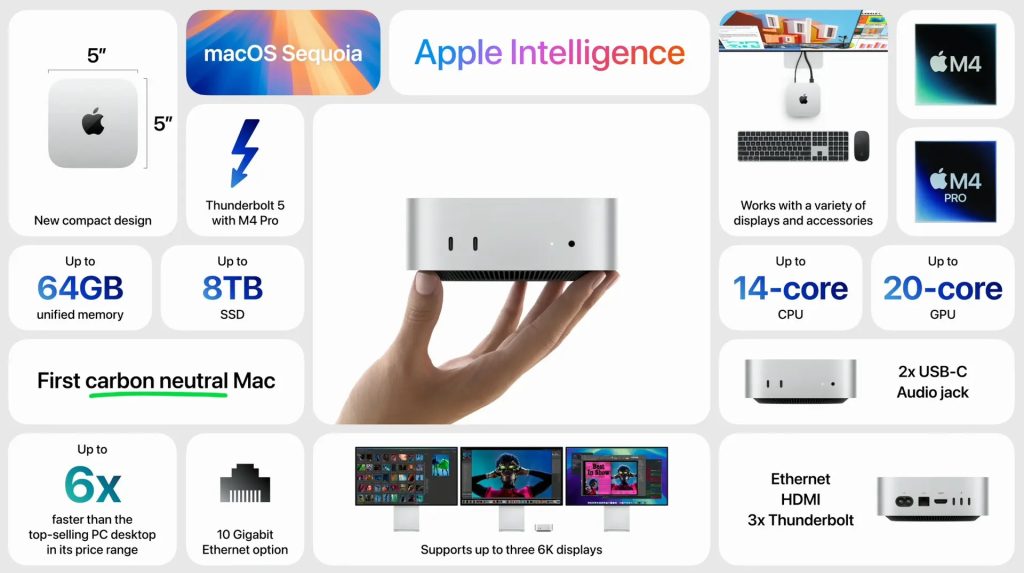
- 16″
- Storage
- RAM
- GPU before RAM
- Video encoders
- Thunderbolt 5
- Nano-texture
Different upgrades come with different benefits, so which investments will give you the best performance, and can you inadvertently imbalance your system?
Thermal Management
For professional video editors considering a laptop, you’ll want to stick to the 16″ MacBook Pro. It has better thermal management (two fans instead of one), which will avoid any heat-related throttling when you crank the machine.
SSD Storage
The only thing that really matters is to get away from the 256GB SSD in the base M4 Mac Mini, which is a $200 upgrade. But ideally, you would have at least 1TB of SSD in your configuration.
Why?
- SSD performance degrades as they fill up
- Apple’s SSD swap memory feature uses SSD storage as temporary RAM when your RAM is full. If that’s in limited supply, you’ll experience performance slowdowns.
Given how expensive Apple’s SSD upgrades are I would go with 1TB or 512 GB in a pinch and use fast, affordable external storage instead.
RAM
Video editing is a graphics-hungry trade. Most video editing software has offloaded a lot of the processing workload to GPU and RAM. Not that the CPU is a slouch either.
As a video editor who wants to use these machines for as long as possible, and given that you cannot update either of these components after purchase, I will always try to upgrade these as much as I can.
According to the Max Tech video above, though, somewhere around 36GB of RAM is plenty for most 4K video editing tasks.
MacBook Pro RAM Options
- M4 Pro 14/20 core: 24GB | 48 GB (+$400)
- M4 Max 14/32 core: 36 GB
- M4 Max 16/40 core: 48 GB | 64 GB (+$200) | 128 GB (+$1,200)
FYI: The better Max chip adds 2 additional performance cores and 8 GPU cores.
How most editors will think: By the time you’re already spending enough to get the best Max chip (+$300) which comes with 48GB of RAM as standard, spending an additional $200 for 64GB of RAM seems like it would be foolish not to…
Mac Mini M4 Pro RAM Options (12/16 or 14/20 core)
- 24 GB | 48 GB (+$400) | 64 GB (+$600)
To get to 64 GB of RAM (what I’m thinking is the sweet spot) that’s an additional $700 on the MacBook Pro and an additional $600 on the M4 Pro Mac Mini.
Understanding Apple Silicon Cores – Performance vs Efficiency vs GPU
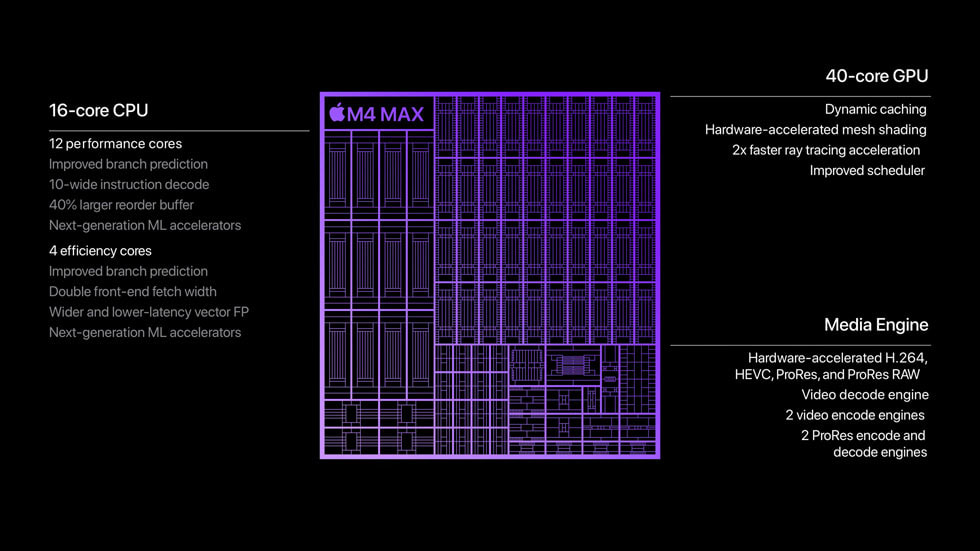
AFAIK: If you max out your RAM capacity without also upgrading your chip, you can unbalance the system, which will not give you the best performance for your money.
This is why it helps to understand the GPU and the performance cores that go into the Apple Silicon unified chips.
The Apple M4 chip has four performance cores and up to six efficiency cores:
- Performance cores: These cores are more powerful.
- Efficiency cores: These cores are more efficient and are used for background tasks that don’t require much processing power.
The M4 chip is available in different models, including:
- M4: 8-core CPU: 4 performance cores and 4 efficiency cores
- M4 Pro: Up to 14-core CPU: 10 performance cores and 4 efficiency cores
- M4 Max: Up to a 16-core CPU: 12 performance cores and 4 efficiency cores
- M4 Pro has up to 20 GPU Cores while the M4 Max has up to 40 GPU Cores
- M4 Max has double the video encode and ProRes encode/decode engine vs the M4 Pro
For video editors, the more performance and GPU cores, the better.
Video Encoders Make a Huge Difference
One of the most time-consuming processes for video editors is exporting your final file. This is where the number of dedicated media encoders on the chips makes a huge difference.
- M4 Pro
- 1 x Video decode/encode engine
- 1 x ProRes encode/decode engine
- AV1 decode
- M4 Max
- 2 x Video decode/encode engine
- 2 x ProRes encode/decode engine
- AV1 decode
- M3 Ultra
- 4 x Video decode/encode engine
- 4 x ProRes encode/decode engine
- AV1 decode
So if you see export times of 10 minutes on a Pro they should be 5 minutes on a Max and 2.5 minutes on an Ultra, as the media encoders are doing a lot of the heavy lifting.
Thunderbolt 5
Faster is always better, especially when you’re transferring hundreds of GBs. Upgrading to get Thunderbolt 5 on the Mac Mini (thus the M4 Pro chip) could be worth it unless you’re out to spend as little as possible.
What does Thunderbolt 5 actually give you?
While Thunderbolt 5 theoretically boasts significantly higher bandwidth (120 Gbps) compared to Thunderbolt 4 (40 Gbps), the practical limit for data connections is currently capped at 80 Gbps.
So the 120 Gbps is more relevant to supporting multiple large displays, although you’ll still get double the data transfer speed!
It can also do some clever things like Thunderbolt Bandwidth Boost and you can still use older Thunderbolt 3 and 4 cables at the new 80 Gbps speeds.
Why this matters: This would all suggest that increasing your SSD will help with having less than the maximum RAM and paying for as many performance and GPU cores as you can will also deliver extra performance for less money.
Therefore if you’re going to invest in a higher-performance machine that should last longer, this configuration might be the best value for long-term performance:

M4 Max 16″ MacBook Pro
- 16-inch Liquid Retina XDR display (Standard display)
- Apple M4 Max chip with 16-core CPU, 40-core GPU and 16-core Neural Engine
- 48 GB unified memory
- 1TB SSD storage
- 3x Thunderbolt 5 ports, HDMI, SDXC card slot, headphone jack, Magsafe
- Cost $3,999
You can actually buy this today on Amazon for $100 cheaper than Apple.
Nano texture
This $150 extra feature is basically a personal decision between matte and glossy.
It’s best decided in person in front of both models in the Apple store, and it’s entirely a personal preference based on your tastes and work environments.
Do you want to cut down on reflections with a nano-etchings in the glass panel of your screen, or do you prefer the slightly crisper glossier look?
Art Is Right has a great breakdown of the differences and side-by-side comparisons.
Thunderbolt 5 Docks and SSDs
While it’s nice that Apple has moved to a greater number of Thunderbolt ports on the Mac Mini and the MacBook Pro, I still have plenty of things in my edit suite that still need to be plugged in via USB-A.
To that end, I’ve been using an OWC Thunderbolt 2 Dock very happily for a long time. But it will make sense to upgrade this to at least a Thunderbolt 4 dock, if not Thunderbolt 5 too.
How many ports do you get?
On the M4 Mac Mini there are three Thunderbolt ports on the back, ethernet and HDMI, plus two USB-C 3 (10 Gb/s) on the front. Plus the headphone jack.
On the M4 MacBook Pro you get three Thunderbolt ports, SDXC, HDMI and a headphone jack.
Backward Compatibility
Thunderbolt 5 is directly backward compatible with Thunderbolt 4 and Thunderbolt 3 cables and devices (docks and drives), although if you use a Thunderbolt 4 cable (or older) you’ll be limited to that generation’s speeds.
So you’ll need a Thunderbolt 5 cable for your new Thunderbolt 5 docks and drives.
- Apple Thunderbolt 5 Cable (1m) – $70
- OWC Thunderbolt 5 Cable (1m) – $40
- Cable Matters Thunderbolt 5 Cable (1m) – $33
Thunderbolt 1 & 2 connectivity – Based on Scott Simmons’ review, you can use a Thunderbolt 3 to 2 Adaptor, like this one from Apple, to connect older devices and drives to your Thunderbolt 5 Mac.
OWC Thunderbolt 5 Dock
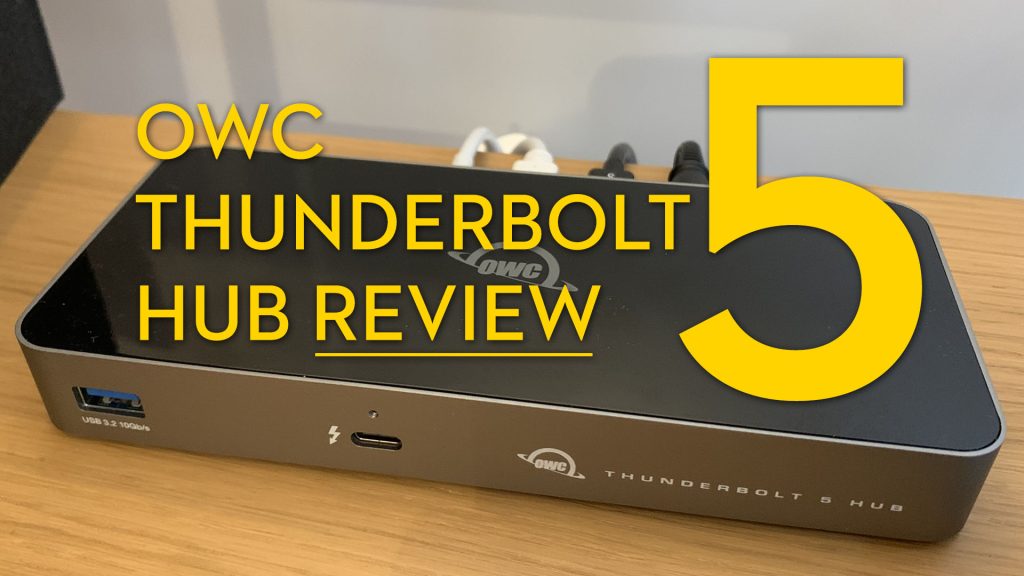
UPDATE – OWC kindly sent me a Thunderbolt 5 Hub to test out and it has become a vital part of my home edit suite ever since.
I now only have to plug in one Thunderbolt 5 cable to my M4 Max Macbook Pro and I’m good to go.
The OWC T5 Hub gives you:
- 1 x Host Thunderbolt 5 (USB-C) port with 140w power
- 3 x Thunderbolt 5 (80 Gb/s bidirectional)
- 1 x USB 3.2 Gen 2 Type-A, up to 10Gb/s (1250MB/s)
You can read my full review here and learn how I used another OWC product to breathe new life into some old tech.
OWC Pre-Production Thunderbolt 5 Dock
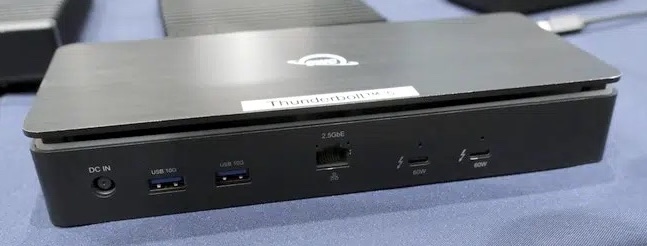
Currently in pre-production OWC will have a Thunderbolt 5 dock, presumably very similar to their Thunderbolt 4 dock (see below) just with faster speeds!
I’ve included a couple of Thunderbolt 4 Docks below for a reference of what is available right now.
Kensington Thunderbolt 5 Dock

Product: Kensington SD5000T5 EQ Thunderbolt™ 5 Triple 4K Docking Station
Ports: 11
- 3 x Thunderbolt™ 5 downstream ports
- 1 x Thunderbolt™ 5 host
- 3 x USB-A 3.2 Gen2 10Gbps ports,
- Combo audio jack
- Dual SD/Micro Card readers
- 2.5Gbps Ethernet for seamless productivity
Price: $399
OWC Thunderbolt 4 Dock
OWC has a trio of docks that would be interesting options.
Their pre-production unit seen above looks like their 10-port Pro Dock ($349), while it would be nice if they updated their 14-port Thunderbolt 3 Dock ($179) – just to have more ports!
There is also the OWC 11-port Thunderbolt 4 Dock too.
Product: OWC 11-port Thunderbolt 4 Dock
Ports:
- 1 x Host Port – Thunderbolt 4 (USB-C) up to 40Gb/s (5000MB/s)
- 3 x Thunderbolt 4 (USB-C) Ports
- 3 x USB 3.2 Gen 2 Type-A Ports up to 10Gb/s (1250MB/s)
- 1 x USB 2.0 Port
- 1 x Gigabit Ethernet (GbE) RJ-45 Port
- 1 x 3.5mm Stereo Audio Input/Output Combo Port
Price: $220
It’s also worth checking on OWC’s Specials page for the latest discounts and deals.
CalDigit Thunderbolt 4 Dock
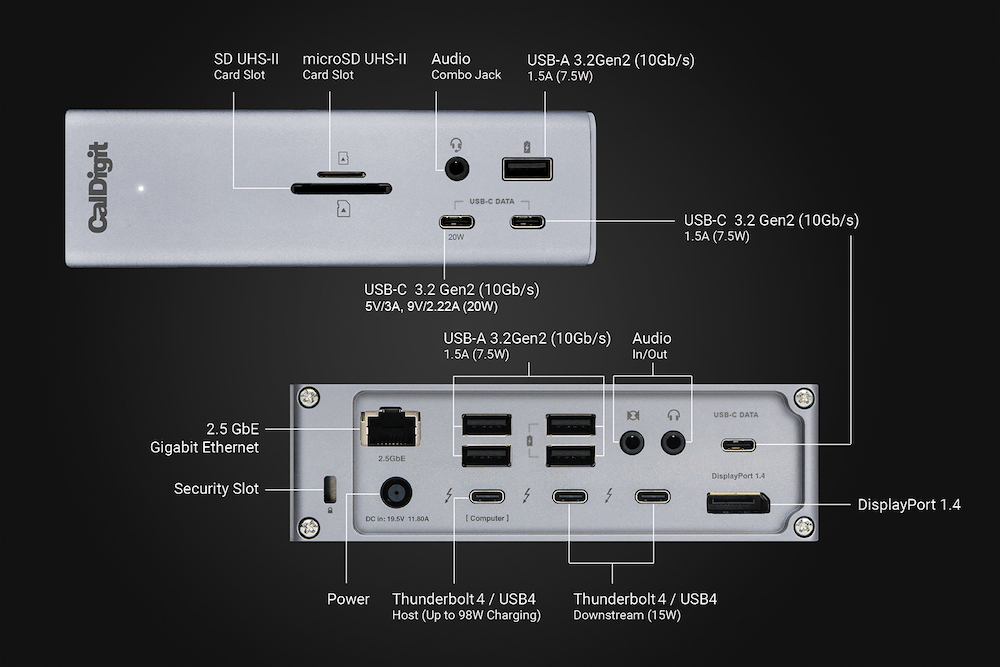
Product: Caldigit TS4 18-port Thunderbolt Dock
Look at all those ports! Plus it can stand up or lie down. It doesn’t roll over though.
Ports: 18
- 3 x Thunderbolt 4 (40Gb/s)
- 3 x USB-C (10Gb/s)
- 5 x USB-A (10Gb/s)
- 1 x DisplayPort 1.4
- 1 x SD 4.0 (UHS-II)
- 1 x microSD 4.0 (UHS-II)
- 1 x 2.5 Gigabit Ethernet
- 1 x Front Combo Audio In/Out (3.5mm)
- 1 x Rear Audio Out (3.5mm)
- 1 x Rear Audio In (3.5mm)
- 1 x DC In (19.5V 11.80A)
Price: $378
Thunderbolt 5 SSDS

There are currently no Thunderbolt 5 SSDs available on the market, although OWC has one in the works that you an pre-order now – The Envoy Ultra ($399) with transfer speeds of up 6,000 MB/s.
I’m sure more will appear soon.
Max tests the OWC Envoy Ultra on several M4 laptops with and without Thunderbolt 5 and the current benefits and limitations of the OWC SSD.
M4 Mac Mini vs M4 MacBook Pro – Which Should Video Editors Buy?

I’m a big fan of the YouTube channel Max Tech.
They do an excellent job of understanding the technical nitty-gritty, staying on top of the latest Apple rumours and performance test all the machines for video editing. All while staying grounded on what is actually worth paying for.
I fed the transcripts of six of their M4 Mac Mini and M4 MacBook Pro (and M4 Mac Studio) videos into Google’s Notebook LLM to crunch all of their data and insights into a single coherent recommendation.
Recommendation for Professional Video Editors
For professional video editors who require a balance of CPU and GPU performance with ample RAM, the sources suggest the M4 Max MacBook Pro in the 16-inch size offers the best value.
- M4 Max Chip: The M4 Max chip delivers a substantial boost in both CPU and GPU capabilities. Although it retains the same 16 CPU cores and 40 GPU cores as the M3 Max, Apple has implemented performance enhancements that result in a 25% increase in graphics performance and impressive single-core performance exceeding 4,000 points.
- 16-inch Model for Optimal Performance: Opting for the 16-inch model is crucial for maximizing the M4 Max chip’s performance potential. The larger chassis accommodates a more robust cooling system, preventing performance throttling that might occur in the smaller 14-inch model when handling demanding video editing tasks.
- RAM Considerations: While the base M4 Max MacBook Pro comes with 32GB of RAM, professional video editors may benefit from upgrading to 64GB for smoother multitasking and handling larger projects. However, it is important to note that the cost of upgrading RAM from Apple is quite high.
- Storage: The sources generally recommend against excessive SSD upgrades due to Apple’s high prices. Instead, they suggest investing in a fast and affordable external SSD for storing large video files and backups.
Why this configuration is better than alternatives:
- M4 Pro Mac Mini: Although the M4 Pro chip offers impressive CPU performance, even surpassing the M2 Ultra in some cases, its GPU capabilities are significantly less powerful than the M4 Max. For video editors, GPU performance is crucial for tasks like rendering and effects processing, making the M4 Max a better choice.
- M4 Ultra Mac Studio: While the forthcoming M4 Ultra Mac Studio promises even greater performance, its estimated starting price of $4,000 makes it a considerably more expensive investment. The M4 Max MacBook Pro delivers excellent performance for a lower price. However, if your video editing work demands the absolute highest level of performance and you are willing to spend more, then waiting for the M4 Ultra Mac Studio might be a better option.
Overall:
The M4 Max MacBook Pro (16-inch) provides a compelling combination of performance, portability, and value for professional video editors. Its powerful CPU and GPU, ample RAM, and efficient cooling system make it well-suited for demanding video editing workflows.
What about the M4 Ultra Mac Studio?
According to the rumours, the M4 Ultra Mac Studio should be released between March and June of 2025, which could only be 4-5 months away.
If it starts at around $4000 for the Ultra with its incredible core counts and anticipated performance metrics, it will definitely be a machine that will last!
But while it would be nice to have all that power and all of those ports in a desktop machine, it’s probably more than I realistically need right now, or will need in the near future.
I can’t see my clients moving to 8K, given that most of what I still deliver is in HD and for the web, plus I can already reasonably edit 4K on my aging laptop and the speed of the storage the files are being pulled from is usually a bigger bottleneck to performance.
I can wait a few more seconds/minutes for things to render and export.
Which M4 Mac Will I Actually Buy?
Well, I don’t know.
If you’re also undecided, this excellent and exhaustive comparison video from ArtIsRight will give you a ton of benchmarks to compare across Mac Mini, Mac Studio, and Macbook Pro – also across multiple chip generations from M1 to M4.
I use my laptop a lot both inside my garden edit suite to drive my main display, peripherals and everything else, and it is really important that I can unplug it all and take it in the house or on the go.
So stumping up for a $4000 M4 Max MacBook Pro seems like a logical decision.
While it would be nice to have both a super-fast laptop and a super-fast desktop, I don’t have a spare £8000 to buy a MacBook Pro and wait for the M4 Ultra Mac Studio. Plus, in reality, I don’t need that level of performance.
M3 Ultra Mac Studio – Current Contender!
With the release of the M3 Ultra Mac Studio, I’ve really had to think hard about what I want to buy.
According to Apple’s own charts, the M3 Ultra looks like it will perform ‘a bit better’ than the M2 Ultra, which, in many of the tests I’ve seen, beats out the M4 Max on video editing tasks—largely due to more RAM and more video encoders.
“When it comes to the CPU, if you’re looking to maximize single-core performance, the M4 Max wins out over the M3 Ultra. It’s single-core performance that makes apps feel speedy, while multi-core performance is what you need for system intensive tasks like 3D rendering and video editing.
The M3 Ultra comes out on top for multi-core CPU performance, and it wins in GPU performance, too.” – Mac Rumors
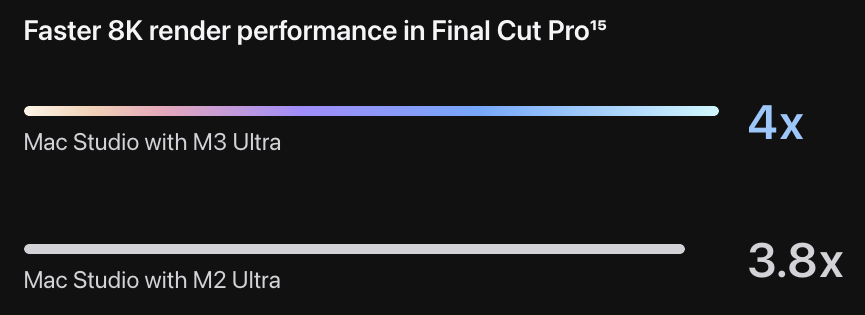
This early leaked test seems to show that the M3 Ultra performs about the same as the M4 Max (ergo, the M2 Ultra).
So if the M2 Ultra can be found for a steal, then it’s likely to deliver great value, but so far, I’ve not seen anything that’s very far from the cost of a new M3 Ultra.
So what do you get for the same money as a nice M4 Max Macbook Pro in the M3 Ultra Studio?
A lot.
- More RAM (96GB vs 64GB)
- More ports (6x vs 3x Thunderbolt 5)
- More video encoders (4 vs 2)
So, for me, it’s a trade-up on performance vs portability and buying a new machine that will serve me well for everything I do versus one that will handle all kinds of video editing tasks for years to come but only from the comfort of my home edit suite.
Decisions!
For even more benchmarks on a massive array of Mac machines from laptops, Mac Mini’s and Mac Studios, check out the latest Art Is Right video. Hit pause to scour those charts for your chosen spec!
Two Cheaper Macs for the Price of One?
Or could I get a cheaper version of both the Mac Mini and MacBook Pro?
- 14-inch Liquid Retina XDR display
- Standard display
- Apple M4 chip with 10-core CPU, 10-core GPU, 16-core Neural Engine
- 16GB unified memory
- 512GB SSD storage
- 70W USB-C Power Adapter
- Three Thunderbolt 4 ports, HDMI port, SDXC card slot, headphone jack, MagSafe 3 port
M4 Pro Mac Mini – $2,199
- Apple M4 Pro chip with 14 core CPU, 20 core GPU, 16-core Neural Engine
- 48GB unified memory
- 1TB SSD storage
- Gigabit Ethernet
- Three Thunderbolt 5 ports, HDMI port, two USB-C ports, headphone jack
Total = $3,800
Which is still cheaper than my original specification for my M4 Max MacBook Pro ($4,199), but neither machine is really all that performant – but certainly good enough!
Can I have my cake and eat it?
Decisions, decisions.
What would you do?
Using M3 Ultra Mac Studio for Video Editing
Apple’s been sending out top-spec M3 Ultra Mac Studio’s to YouTube reviewers and the early opinions are mostly what you’d expect:
- 41% faster than M4 Max Macbook Pro (Cinebench R24 Multi-core)
- 43% faster than M4 Max Macbook Pro (Adobe Premiere Pro)
- 40 seconds faster than Ma 4 Max Macbook Pro (DaVinci Resolve 4K H.264 export)
M3 Ultra Mac Studio Spec: 32/80 CPU/GPU. 32-Core Neural Engine. 256 GB RAM.
M4 Max Macbook Pro Spec: 16/40 CPU/GPU. 16-Core Neural Engine. 128 GB RAM.
If you’re a video creator, you should really stick with the M4 Max. I don’t think paying extra for the M3 Ultra is worth it this time. You’re just getting really similar performance in those Creative Suite of applications.
My suggestion is upgrade to the Mac Studio with the M3 Ultra if you’re using large language models or if you need as much GPU power as possible using a Mac-based system.
– Matthew Moniz
M3 Ultra Mac Studio Spec: 32/80 CPU/GPU. 32-Core Neural Engine. 512 GB RAM.
M4 Max Macbook Pro Spec: 16/40 CPU/GPU. 16-Core Neural Engine. 128 GB RAM.
In Final Cut Pro the extra video encoders prove their worth when exporting a 3 minute 8K short film:
- M4 Max Macbook Pro: 18min and 14 seconds
- M3 Ultra Mac Studio: 10min and 3 seconds
Topaz Video AI
- M4 Max Macbook Pro: 4 min 10 seconds
- M3 Ultra Mac Studio: 3 min 22 seconds
Tyler also tests the M3 Ultra Mac Studio in DaVinci Resolve.
Apple M4 Max Video Editing Performance Comparisons
Just how good is the new M4 Max chip?
The general gist is that the M4 Max is as fast as an M2 Ultra and almost twice as fast as the M1 Max.
If you already own an M3 it’s probably not worth upgrading at this point, given the marginal performance gains – you’re only saving a few seconds in comparison.
One challenge with watching video editing testing videos is that, while you can see the specs and the time elapsed, without knowing how much the other variables are playing a role: storage speeds, codec types, filter settings, etc. It’s tough to extrapolate to your own work the exact performance gains you might experience.
Plus when the savings are only a few seconds in export times or rendering, do you really want to burn this much money for such marginal performance improvements?
ArtIsRight has excellent, very detailed technical comparisons of the performance of the different M4 Mac chips and a sound rationale for choosing one.
Buy an M3 Max – Cheaper and Almost as Good
That said, if you need to upgrade now, a discounted M3 Max MacBook Pro could save you quite a bit of money and deliver almost as good performance.
For example, this 16″ M3 Max MacBook Pro with 16/40 Core, 48GB RAM and 1TB SSD is 20% cheaper at $3240!


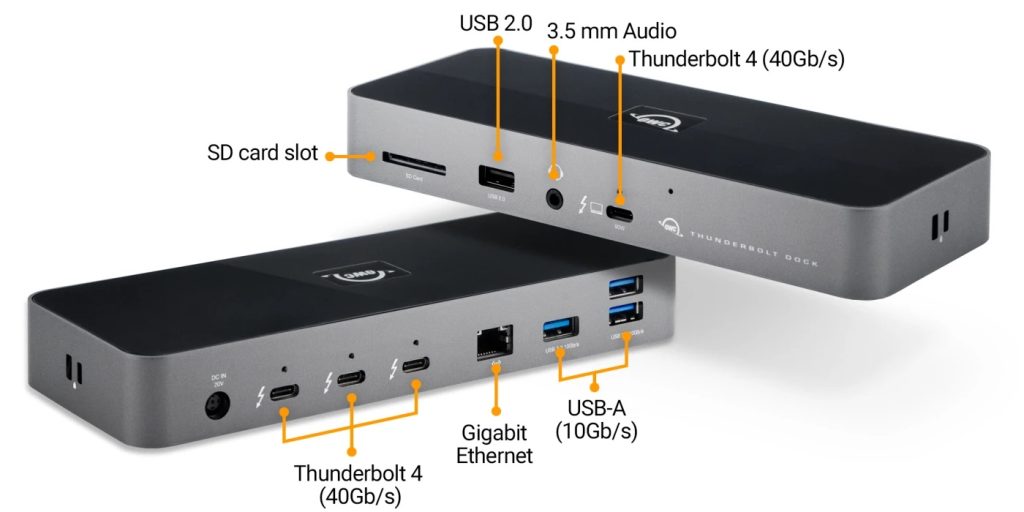




Hi – really excellent thank you – can you help – I’ve been using an M1 Max studio and want to replace it – mostly 4k editing – should I go for m4 max with more ram and 1tb disc (I would like a desktop rather than a laptop) thank you!
The M4 Max will be a great value machine – double the media engines of the M4 Pro and a lot more affordable than the M3 Ultra. I would suggest that the extra money to increase the chip (+$300) which also gets you to 48GB RAM (possibly go up to 64GB +$200 for longevity) + the 1TB drive = great mac that will last for just under $3K.
Hi Jonny – thank-you – I think I bought my current Mac Studio on your recommendation a few years back and it’s been great. Of course the question is : get an M4 now or wait for the M5….it never ends!
Well glad it was useful!
Yeah it looks like could be ‘early 2026 for the M5 Max’ so – maybe it’s worth holding out??
It’s possible though that the increase between the M4 and M5 will be a bit like between M2 and M3 (so smaller) than between M3 and M4 (more substantial – I think)
I haven’t checked early reports on the M5 yet.
“Apple already debuted the M5 chip in the MacBook Pro, but we’ll be waiting until early 2026 for the M5 Pro and the M5 Max. The M5 Ultra will likely come after that, perhaps in June or even September 2026.”
https://www.macrumors.com/2025/11/04/mac-studio-m5-ultra-2026/
Hi Jonny,
I am about to edit a feature-length documentary in 4K.
I presume a Mac Studio M4 Max with 16?core CPU, 40?core GPU, 16?core Neural Engine
64GB unified memory and 2TB SSD drive would be up to the task.
What are your thoughts?
Thank you for your time and insights.
Yes. Also make sure you have a decent hard drive to edit from. https://jonnyelwyn.co.uk/thunderbolt/which-harddrive-should-i-buy-for-video-editing/
What kind of footage are you working with?
Thank you so much for your prompt answer.
Mixed footage and archive. Interviews were shot in 10bit 422 using Sony FX6 and Blackmagic Cinema Pocket camera Pro.
Thank you for the link to the driver.
Really useful article – thank you Jonny. I’m not clear on how you arrived at so much RAM (64GB as “the sweet spot”) as necessary for the mid-power machines like the Mac Mini M4 Pro. I’m looking at that machine and from my research 32GB would be ideal (see Max Tech for example), but it only comes with either 24GB or 48GB (the latter for an extra $400). From my limited understanding, that extra $400 may be wasted as 48GB is overkill on the M4 Pro and 24GB RAM would be more than enough for most use cases. Can you add any thoughts on why it might be worth going for the 48GB over 24GB?
Hey Matt. my thought on increasing the RAM is two-fold. 1) For video editing apps, the more RAM the better and 2) multi-year longevity (assuming apps eat even more RAM in the future).
But that’s also partly due to my purchasing philosophy of buy the best I can and keep it as long as I can – hence why I’m still rolling with a 2017, 2.9 GHz Quad-Core Intel Core i7 with 16GB of RAM.
And the fact that you can’t upgrade anything on these machines after purchase.
All of which also leads to the most salient point – ANY of these machines will be a huge step up from my current system, and ANY of them can edit under most ‘normal’ video editing tasks quite easily.
Often the bottle neck to performance with 4K, 6K, 8K etc is actually the media drive speed.
You’ll probably be 100% fine with the M4 Pro Mac Mini and 24GB RAM! Save the money!
Also check out page 13 of this best practices guide from Adobe – It suggests a minimum of 64GB for a pro-workstation. It’s from 2022.
https://helpx.adobe.com/content/dam/help/en/premiere-pro/using/long-form-episodic-best-practices/jcr_content/root/content/flex/items/position/position-par/download_section/download-2/Premiere-Pro-Best-Practices-Guide.pdf
With M4 Ultra Apple will be entering gaming space, this will be a serious rival to RTX 5000 series… M4 Ultra will be cutting edge in machine learning and ultra high end graphics work. The M4 Ultra will presumably have a max of hundreds of gigabytes of VRAM available though… if anyone will ever need that power 🙂
It looks like it should be a beast – https://www.youtube.com/watch?v=0sU3z7OSalw
I’m in a very similar position. Current set up is a 2019 iMac i9 and M1 air. In all honesty, I can keep going with what I’m doing, but just feel it’s “time” as I’m editing a lot more 6k footage. Right now, I’m leaning towards the base M4 Pro Mini (with upgraded ram) and waiting a couple of months for the M4 air (15 inch). I’ll be giving up a bit of performance (mostly in terms of render and export times – which is when the tea gets made anyway), but the value is undeniable and I think those will be more than enough for what I’m doing. I love my air for travel, so ideally want to keep things lighter for my portable machine. I also think those models aren’t upgraded enough to take them out of popular resale territory and will hold their value. I’m generally on more of a 3-4 year ownership cycle.
Thanks for sharing and that sounds like a solid decision!
Great article, because I am exactly in the same situation. My latest projects were a pain to edit on my old MacBook.
I will decide for the MacBook Pro option, because it’s portable and I sometimes have to work on projects from hotel rooms.
If I wouldn’t need to do this I’d rather opt for the Mac Mini or Studio option and get an iPad Pro as a portable device.
Thanks for your insights!